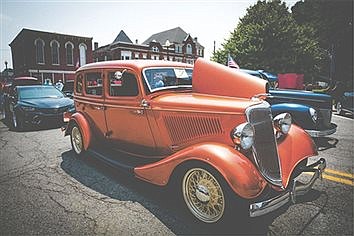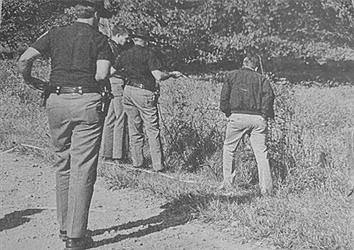Rural Indiana, like cities, hit with housing shortages
February 12, 2025 at 10:43 a.m.

After living in Florida just long enough to ride out the pandemic, Debbie and Mark Davis realized they were longing to return to an Indiana home.
So the couple sold their place in the Sunshine State, and came back to the land of Hoosier hospitality, planning to live just temporarily with their adult daughter.
But as they began looking for a house in Rushville, a city they’d called home for more than 20 years before seeking comfort in the south, they were shocked at what they found.
Prices had soared.
“Homes were outrageous,” Debbie Davis said.
Small cracker box houses in older neighborhoods, which once would have sold for about $80,000, were listing at more than $200,000 despite the lack of any structural or cosmetic improvements warranting the increase.
In Rushville, where the median household income in 2023 was just over $57,000, that kind of investment just isn’t realistic for many residents.
The Davises soon learned that the challenge of finding affordable housing is just as frustrating for families in rural communities like Rushville, as it is for those trying to buy or rent in urban areas. In the last decade, housing prices in rural Indiana have nearly doubled, keeping pace with similar increases in urban centers across the Midwest.
Experts at Prosperity Indiana, in partnership with the National Low Income Housing Coalition, report a “staggering shortage of affordable homes.” For low-income renters, Indiana has a shortage of more than 100,000 affordable rental homes, according to the 2024 Indiana Housing Profile.
The situation isn’t much better for families looking to buy a home.
Matt Kinghorn, senior demographer at the Indiana Business Research Center, described Indiana’s growing affordability crisis by the numbers. Since the start of the pandemic alone, a 42% increase in Indiana home values, coupled with decreased new home building and higher mortgage rates, “means the cost of homeownership is increasingly beyond the reach of many prospective home buyers.”
The median sale price of a home in Indiana rose to $252,000 in 2024, a 7% increase from 2023.
Across the state, city leaders are seeking ways to expand their affordable housing stock, but solutions can be even more difficult in small rural centers like Rushville.
Lower volume and sales prices, and narrower profit margins, have traditionally discouraged developers from venturing too far from urban centers. So, in Rushville, a city of 6,000 an hour southeast of Indianapolis, new construction has been scarce. And some older neighborhoods have become blighted, as residents die, and younger people leave for other opportunities.
Making the challenge even greater, Rushville has experienced a surge of new jobs, coupled with not enough housing, said Kyle Gardner, the city’s director of special projects.
Companies including Missouri-based Diamond Pet Foods, which built its first Indiana facility in Rushville in 2022, and Trane Technologies, a commercial heating and air conditioning company, are adding 170 and 75 jobs respectively. And Copland Corp., a compressor manufacturing facility is adding 75 as well.
The jobs are a welcome addition to the community, Gardner said. But now what to do with those employees who might be filling those jobs?
Old neighborhoods, new houses
The housing difficulties are personal for Gardner.
The lifelong Rush County resident left just long enough to secure a business management degree from IUPUI. Rushville is where he wants to raise his family, and it’s where he’s hoping others will choose to do the same.
So Gardner and his colleagues had to start thinking about the problem a little differently. One of the first steps: Work to rid the city of those habitual problematic properties, and replace them with habitable structures to alleviate the housing squeeze.
Rush County was awarded $5 million through a Lilly Endowment grant, Gardner said. That money will be used across the county for blight reduction, broadband expansion and recreation work like park or trail construction. About $2 million of it will go toward residential blight elimination.
Enter Holly Robertson Smith and her husband, Justin Smith.
The couple take advantage of the blight reduction program to build new houses priced below $200,000 mostly in Rushville, in neighborhoods that haven’t seen new construction in decades.
Before the Smiths started building houses, they were rehabbing existing homes and renting them out.
“But the last house we flipped, we put it online as soon as we bought it, advertising that we were going to rent it out,” Justin said.
Before a single hammer swing, more than 80 people in Rushville called either Holly or Justin, looking for a way to get into that home.
That realization sparked an idea. Rather than buying land in Rush County — estimated to sell for nearly $14,000 an acre — and getting water, sewer, electricity and other utilities connected, the Smiths could work inside Rushville’s city limits, building new-construction homes.
So when the Davises returned from Florida and started looking, and failing, in their home search, they turned to the Smiths.
“What was appealing to me about building a new home is that everything is new,” Debbie said. “I’m not going to spend $180,000 on someone’s house that’s falling down and have to redo everything.”
Instead, the Davises, working with the Smiths, built a three-bedroom, two-bathroom house for $170,000 on land that had previously held property that was in Rushville’s blight reduction plan.
City officials count their story as a victory. “Rushville saw a lot of success over the last several years by getting blighted properties cleaned up and into the hands of developers,” Gardner said. “I hope we can duplicate and even improve the process.”
More than 120 new homes in the works
The anti-blight program is one of at least three different projects under way in the city to address the housing shortage.
The first is a new construction, 22-home development called “The Lakes at Rushville” between 16th and Spencer streets. In the first phase, Greenfield-based Joyner Homes is offering plans that start at a cost of $275,900, with land and site costs not included. With land and other expenses, the total cost can be closer to $350,000.
City administrators say they know that for some, a $350,000 house, or even a $175,000 house, won’t be affordable, Gardner said. But those options will appeal to others.
“Just like we need workers of all skills and at all levels, we need types of houses for all needs, too,” he said.
To attract Joyner Homes to Rushville, Gardner said the city spent $1.8 million for infrastructure development, including water, sanitary sewer, storm sewer, streets and curb installation. The second phase will add another 30 homes, with an additional $2 million infrastructure investment by the city.
A second project the city has started is called the North Washington Housing development.
The 33 single-family homes, which Gardner said are designed to be more affordable for families, are expected to sell in the $175,000 to $225,000 range.
Construction on that project began last May, with the city contributing $1.55 million from Regional Economic Acceleration and Development Initiative funds for infrastructure. That money was made available through the Indiana Economic Development Corp., a public-private partnership led by the Indiana secretary of commerce.
A final project will bring 40 market-rate apartments to Rushville.
In a city the size of Rushville, the construction of more than 120 new homes can have a significant impact. And Gardner is proud of the work they’re doing.
“Rushville’s approach to in-fill housing and infrastructure development could certainly serve as a roadmap for other small, rural communities facing similar challenges,” Gardner said. “Many rural markets struggle to attract private developers due to lower housing demand, lower return on investment, and higher infrastructure costs relative to potential revenue.”
A chain reaction of neighborhood improvement
As for the Smiths, who plan to keep building new homes in blighted areas, they feel as if they are making a difference.
“The community is just so excited that something new (is happening) and that it’s all getting improved,” Justin said.
It’s a challenge, at times, to make everything work on a project, the couple said.
“Every time I’m like…‘I don’t know if I’m going to do this again.’ And then by the end it’s so rewarding,” Holly said.
“We’re never going to be millionaires,” Justin added, laughing. “We enjoy doing it, but we will never go buy a jet.”
“But look at Debbie,” Holly continued. “She would be living with her daughter right now if this didn’t happen.”
Debbie Davis agrees.
“We’ve always been middle class. I mean, you know, we live paycheck to paycheck,” she said. “For us to be able to afford a new home like this is pretty grand.”
Gardner points to the different initiatives as a way the city is trying to help, because more housing options can help stabilize Rushville’s population, boosting property and income taxes, and school enrollment.
“The biggest hurdle for a small rural community to overcome can be the funding for these projects,” he said, noting the city’s aggressive approach to grant applications and development deals. “Sitting back and waiting for something to happen rarely works in most communities.
“Are we perfect?” Gardner asked. “Not at all. But things are happening in a small town that was once (where things were) seen as doom and gloom.”
Lisa Renze works with projects and partnerships with Free Press Indiana, an organization that works to support nonprofit news efforts, including at Mirror Indy. Reach her at [email protected].
Latest News
E-Editions
Events
After living in Florida just long enough to ride out the pandemic, Debbie and Mark Davis realized they were longing to return to an Indiana home.
So the couple sold their place in the Sunshine State, and came back to the land of Hoosier hospitality, planning to live just temporarily with their adult daughter.
But as they began looking for a house in Rushville, a city they’d called home for more than 20 years before seeking comfort in the south, they were shocked at what they found.
Prices had soared.
“Homes were outrageous,” Debbie Davis said.
Small cracker box houses in older neighborhoods, which once would have sold for about $80,000, were listing at more than $200,000 despite the lack of any structural or cosmetic improvements warranting the increase.
In Rushville, where the median household income in 2023 was just over $57,000, that kind of investment just isn’t realistic for many residents.
The Davises soon learned that the challenge of finding affordable housing is just as frustrating for families in rural communities like Rushville, as it is for those trying to buy or rent in urban areas. In the last decade, housing prices in rural Indiana have nearly doubled, keeping pace with similar increases in urban centers across the Midwest.
Experts at Prosperity Indiana, in partnership with the National Low Income Housing Coalition, report a “staggering shortage of affordable homes.” For low-income renters, Indiana has a shortage of more than 100,000 affordable rental homes, according to the 2024 Indiana Housing Profile.
The situation isn’t much better for families looking to buy a home.
Matt Kinghorn, senior demographer at the Indiana Business Research Center, described Indiana’s growing affordability crisis by the numbers. Since the start of the pandemic alone, a 42% increase in Indiana home values, coupled with decreased new home building and higher mortgage rates, “means the cost of homeownership is increasingly beyond the reach of many prospective home buyers.”
The median sale price of a home in Indiana rose to $252,000 in 2024, a 7% increase from 2023.
Across the state, city leaders are seeking ways to expand their affordable housing stock, but solutions can be even more difficult in small rural centers like Rushville.
Lower volume and sales prices, and narrower profit margins, have traditionally discouraged developers from venturing too far from urban centers. So, in Rushville, a city of 6,000 an hour southeast of Indianapolis, new construction has been scarce. And some older neighborhoods have become blighted, as residents die, and younger people leave for other opportunities.
Making the challenge even greater, Rushville has experienced a surge of new jobs, coupled with not enough housing, said Kyle Gardner, the city’s director of special projects.
Companies including Missouri-based Diamond Pet Foods, which built its first Indiana facility in Rushville in 2022, and Trane Technologies, a commercial heating and air conditioning company, are adding 170 and 75 jobs respectively. And Copland Corp., a compressor manufacturing facility is adding 75 as well.
The jobs are a welcome addition to the community, Gardner said. But now what to do with those employees who might be filling those jobs?
Old neighborhoods, new houses
The housing difficulties are personal for Gardner.
The lifelong Rush County resident left just long enough to secure a business management degree from IUPUI. Rushville is where he wants to raise his family, and it’s where he’s hoping others will choose to do the same.
So Gardner and his colleagues had to start thinking about the problem a little differently. One of the first steps: Work to rid the city of those habitual problematic properties, and replace them with habitable structures to alleviate the housing squeeze.
Rush County was awarded $5 million through a Lilly Endowment grant, Gardner said. That money will be used across the county for blight reduction, broadband expansion and recreation work like park or trail construction. About $2 million of it will go toward residential blight elimination.
Enter Holly Robertson Smith and her husband, Justin Smith.
The couple take advantage of the blight reduction program to build new houses priced below $200,000 mostly in Rushville, in neighborhoods that haven’t seen new construction in decades.
Before the Smiths started building houses, they were rehabbing existing homes and renting them out.
“But the last house we flipped, we put it online as soon as we bought it, advertising that we were going to rent it out,” Justin said.
Before a single hammer swing, more than 80 people in Rushville called either Holly or Justin, looking for a way to get into that home.
That realization sparked an idea. Rather than buying land in Rush County — estimated to sell for nearly $14,000 an acre — and getting water, sewer, electricity and other utilities connected, the Smiths could work inside Rushville’s city limits, building new-construction homes.
So when the Davises returned from Florida and started looking, and failing, in their home search, they turned to the Smiths.
“What was appealing to me about building a new home is that everything is new,” Debbie said. “I’m not going to spend $180,000 on someone’s house that’s falling down and have to redo everything.”
Instead, the Davises, working with the Smiths, built a three-bedroom, two-bathroom house for $170,000 on land that had previously held property that was in Rushville’s blight reduction plan.
City officials count their story as a victory. “Rushville saw a lot of success over the last several years by getting blighted properties cleaned up and into the hands of developers,” Gardner said. “I hope we can duplicate and even improve the process.”
More than 120 new homes in the works
The anti-blight program is one of at least three different projects under way in the city to address the housing shortage.
The first is a new construction, 22-home development called “The Lakes at Rushville” between 16th and Spencer streets. In the first phase, Greenfield-based Joyner Homes is offering plans that start at a cost of $275,900, with land and site costs not included. With land and other expenses, the total cost can be closer to $350,000.
City administrators say they know that for some, a $350,000 house, or even a $175,000 house, won’t be affordable, Gardner said. But those options will appeal to others.
“Just like we need workers of all skills and at all levels, we need types of houses for all needs, too,” he said.
To attract Joyner Homes to Rushville, Gardner said the city spent $1.8 million for infrastructure development, including water, sanitary sewer, storm sewer, streets and curb installation. The second phase will add another 30 homes, with an additional $2 million infrastructure investment by the city.
A second project the city has started is called the North Washington Housing development.
The 33 single-family homes, which Gardner said are designed to be more affordable for families, are expected to sell in the $175,000 to $225,000 range.
Construction on that project began last May, with the city contributing $1.55 million from Regional Economic Acceleration and Development Initiative funds for infrastructure. That money was made available through the Indiana Economic Development Corp., a public-private partnership led by the Indiana secretary of commerce.
A final project will bring 40 market-rate apartments to Rushville.
In a city the size of Rushville, the construction of more than 120 new homes can have a significant impact. And Gardner is proud of the work they’re doing.
“Rushville’s approach to in-fill housing and infrastructure development could certainly serve as a roadmap for other small, rural communities facing similar challenges,” Gardner said. “Many rural markets struggle to attract private developers due to lower housing demand, lower return on investment, and higher infrastructure costs relative to potential revenue.”
A chain reaction of neighborhood improvement
As for the Smiths, who plan to keep building new homes in blighted areas, they feel as if they are making a difference.
“The community is just so excited that something new (is happening) and that it’s all getting improved,” Justin said.
It’s a challenge, at times, to make everything work on a project, the couple said.
“Every time I’m like…‘I don’t know if I’m going to do this again.’ And then by the end it’s so rewarding,” Holly said.
“We’re never going to be millionaires,” Justin added, laughing. “We enjoy doing it, but we will never go buy a jet.”
“But look at Debbie,” Holly continued. “She would be living with her daughter right now if this didn’t happen.”
Debbie Davis agrees.
“We’ve always been middle class. I mean, you know, we live paycheck to paycheck,” she said. “For us to be able to afford a new home like this is pretty grand.”
Gardner points to the different initiatives as a way the city is trying to help, because more housing options can help stabilize Rushville’s population, boosting property and income taxes, and school enrollment.
“The biggest hurdle for a small rural community to overcome can be the funding for these projects,” he said, noting the city’s aggressive approach to grant applications and development deals. “Sitting back and waiting for something to happen rarely works in most communities.
“Are we perfect?” Gardner asked. “Not at all. But things are happening in a small town that was once (where things were) seen as doom and gloom.”
Lisa Renze works with projects and partnerships with Free Press Indiana, an organization that works to support nonprofit news efforts, including at Mirror Indy. Reach her at [email protected].





